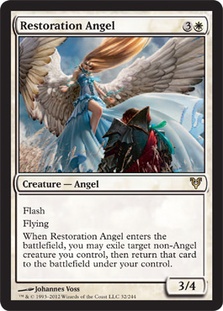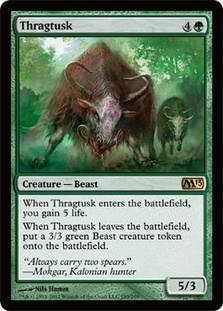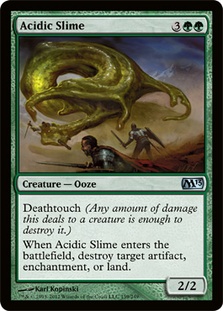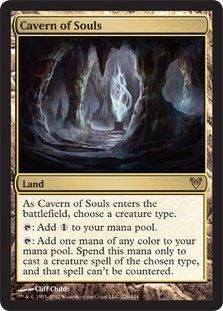Hello everyone,
In today’s article, we are going to take a closer look at Standard Reanimator, which we (Martin Juza, Lukas Jaklovsky, Shuhei Nakamura, and I) played at Grand Prix Verona. Martin gave me the idea that Reanimator would be great in the current metagame since it’s very difficult for most of the slower decks like U/W/R and Jund to deal with your graveyard plan in game 1. Also, the graveyard hate they could bring in for games 2 and 3 isn’t game-breaking against you like it is for Human Reanimator because creatures like Thragtusk and especially Obzedat, Ghost Council are serious threats even without the graveyard engine. I played the deck for a few days on Magic Online, and after I made several changes to the maindeck and sideboard, I was really happy with it.
At the GP, we had a great day 1. We all made Day 2—three of us were 8-1 and one was 7-2. Day 2 didn’t go the way we wanted, though. At one point, Martin and I were 10-1, but then we went on an “unlucky streak” that ended with Martin’s loss for Top 8. Still, we all finished in the money except for Shuhei, which I consider solid, and from my point of view, it was the best choice for the tournament. I finished in the Top 64 with a record of 11-5 including three byes. I went 4-1 against Big Jund, 0-3 versus Jund Aggro, 2-0 against U/W/R, 1-1 against Reanimator, and 1-0 versus Mono-Red Aggro.
I was really disappointed with my three losses to Jund Aggro because I don’t think it’s a bad matchup for this deck, but I have to say that I was somehow smashed in the games I played against it at the GP. In one match, I had problems with mana; in another, my opponent had really nice draws; and in the third one, my opponent surprised me with Olivia Voldaren, which unanswered meant GG.
The Deck
Creatures (24)
- 2 Borderland Ranger
- 4 Arbor Elf
- 4 Avacyn's Pilgrim
- 3 Restoration Angel
- 1 Craterhoof Behemoth
- 4 Thragtusk
- 4 Angel of Serenity
- 2 Centaur Healer
Lands (23)
Spells (13)

The good thing about the deck is that you get to play your own game, which is very powerful in current Standard, and you have a good matchup against most of the “random” decks because your game plan doesn’t rely on having the correct answer at the right time like Jund does.
The biggest weakness of the deck is mana. You play some very expensive creatures like Angel of Serenity and Craterhoof Behemoth, and in some games you simply don’t have enough time to cast them, while in other games you are flooded since your deck has a lot of mana sources. Another big problem for the deck is colored mana. You need to play as many Forests as possible in order to support Arbor Elf (with twelve Forests, you still have almost a one in four chance that you are not going to have Forest if you have Arbor Elf in your opening hand). Casting spells with triple white or WWBB is problematic as well.
It’s possible to cut one Gavony Township, one Forest, and one Arbor Elf for one Sunpetal Grove, one Woodland Cemetery, and one Cavern of Souls in order to improve your colored mana and make your deck slightly more stable for the cost of losing some speed. Your Arbor Elfs would also be slightly worse, and Township is kind of important against Jund, U/W/R, the mirror, and especially Naya decks.
The heart of the deck is the graveyard engine. Mulch gives you more mana to cast your expensive spells and fill your graveyard, while Grisly Salvage does even more because you have the possibility of picking a creature to go into your hand, which makes it probably the best card in the deck. Unburial Rites works really well with these cards since if it’s milled it provides you with card advantage. Also, it’s much faster to “cheat” fatties into play with Unburial Rites than to hard cast them.
The main difference between Human Reanimator and this Reanimator deck is their defensive resources. Human Reanimator can buy time with Burning-Tree Emissary and Huntmaster of the Fells, but it really needs to complete its combo at some point. This Reanimator deck wins a lot of games by simply casting midrange creatures. The ability to survive the early turns against aggro decks is much higher for this version since you have more accelerators and Centaur Healer, Restoration Angel and Thragtusk to provide great defense.
While Thragtusk is good against aggro, it’s great in other matchups as well. You win lot of games against decks full of removal by casting Thragtusk and bringing it back with Unburial Rites because your opponent would need six removal spells to fully deal with this combination of cards.
The “big weight” of this deck is Angel of Serenity. Despite its terrible mana cost, it provides you with such important things that it’s hard not to play four of it. It’s usually the best target for Unburial Rites since it provides you with massive card advantage and deals with the opponent’s creatures at same time. It’s the most crucial against Jund because it’s your way to deal with the otherwise game-breaking Olivia Voldaren. The possibility of chaining Angels is very important against control decks because it ensures you don’t run out of gas. Despite it being somewhat slow against aggro, it’s not bad there since a resolved Angel can completely turn around virtually any game.
The last fatty in the deck is Craterhoof Behemoth. Although it is almost a mulligan against aggro decks, against control/combo decks it is so game breaking that you need to play it. It is especially important against Sphinx’s Revelation decks since if they have enough card advantage even the Angel of Serenity chain could not be enough, so your only way of winning is Behemoth.
Maindeck Sever the Bloodline might be surprising, but it’s exactly what the deck needs because it gives it more options. It deals with problematic creatures like Olivia, Frontline Medic, and Angel of Serenity, and due its flashback, it provides you with a better late game and makes cards like Mulch and Salvage slightly better.
The most unobtrusive card is Borderland Ranger, but it provides you with both mana fixing and a body. It fits very nicely into the deck since it has good synergy with Gavony Township, Vault of Archangel, and Restoration Angel.
Possible Cards I Did Not Run Maindeck
Lingering Souls – Despite this card being extremely powerful, the 1/1 Spirits don’t do much in current Standard. I think Centaur Healer + Restoration Angel is a better way to defend against most of the current aggro decks, and with other 1/1s, your deck would be extremely vulnerable to Bonfire of Damned. But Lingering Souls has great synergy with Craterhoof Behemoth, so if you’re looking for fast kill in order to improve match-ups like Human Reanimator or Esper Control, this is a card for you.
Acidic Slime – I have to say I don’t like Acidic Slime at all, even as a sideboard card. It allows you to completely cripple your opponent in some games by playing it fast and Blinking it with Angel or returning it with Rites, but if you draw it randomly in the late game, especially when you’re behind, it doesn’t do enough in comparison to other cards you could be playing instead. This is a typical “win more” card, and you should stay away from this type of card.
Deathrite Shaman – In Standard, Deathrite Shaman is not able to produce mana most of the time, and his other abilities aren’t good enough against most of the decks in order to it maindeck material at the moment. But Shaman is great against other Reanimator decks, and if they become more popular (and I believe they will), it’s possible that it will be necessary to run him maindeck. Otherwise, your chances in the mirror match wouldn’t be very good.
Loxodon Smiter – This card could fight with Centaur Healer for a slot in the maindeck. I believe in the current version that Centaur Healer is slightly better due to its great interaction with Restoration Angel, but if you change the deck and cut some Angels for something like Lingering Souls, Loxodon Smiter could be better for you. It also depends on which decks are played in your area. Smiter works well against decks full of 3/3s and Searing Spear, while Healer is great against decks full of cheap creatures. Smiter is also better against control decks, so this card could be a solution if you want to improve these matchups and still have a solid card against aggro decks.
Sideboard
Abrupt Decay – This is a very flexible card. It deals with graveyard hate like Deathrite Shaman, Gravedigger’s Cage, and Ground Seal and dangerous creatures like Frontline Medic. It’s a good way to stop the Charm combo by killing Boros Reckoner, and it can destroy random permanents like Underworld Connections.
Deathrite Shaman – I think this is the best card against Reanimator decks, even better than Purify the Grave. If these decks become more popular, you should have four Shamans in your 75. It’s also possible to side Shamans in against hyperaggressive decks to lower your curve.
Restoration Angel – It might look weird to have Angel in the sideboard, but it gets better after game 1 when you bring more Centaur Healers in. It’s also very good against U/W/R since it can deal with Boros Reckoner and is slightly better than it would be in game 1 because you are bringing in Cavern of Souls.
Obzedat, Ghost Council – This is an extremely good card, but the big problem with it is its mana cost. You should bring him in against almost all non-aggro decks since you’ll have enough time to get him into play and he’s really hard to deal with.
Cavern of Souls – This card is in the sideboard in order to help you cast problematic creatures like Angel of Serenity and Obzedat, Ghost Council in matchups that aren’t really about tempo like Sphinx’s Revelation decks or Jund. It’s even better because blue decks usually sideboard in more counterspells against you.
Other Possible Sideboard Cards
Garruk, Primal Hunter – This card is really sweet, and the only reason that it’s not in sideboard is that it’s another five-drop and you can’t have too many of them. Obzedat, Ghost Council is simply better, especially because you have Cavern of Souls in your deck.
Curse of Death’s Hold – An elegant way to deal with opposing 1/1s. This would be a nice addition for the mirror match and decks with Lingering Souls.
Rhox Faithmender – If you are looking for more anti-aggro cards, this is your guy.
Duress – Good sideboard option against blue decks and Jund.
Sideboard Guide
Take this with a grain of salt because not everyone plays the same cards in the same archetype, so the optimal sideboard plan against a particular opponent might be different from the one posted here. But I believe you can’t go wrong with following changes:
Humans
+3 Abrupt Decay, +2 Centaur Healer, +1 Restoration Angel, +2 Sever the Bloodline
-3 Unburial Rites,-2 Mulch, -2 Angel of Serenity, -1 Craterhoof Behemoth
On the draw extra: +3 Deathrite Shaman, -1 Mulch, -2 Borderland Ranger
Unburial Rites isn’t very exciting in this matchup since creatures don’t trade much. You need to side in a lot of removal in order to deal with problematic creatures like Mayor of Avabruck and especially Frontline Medic.
Mono-Red Aggro
+3 Abrupt Decay, +2 Centaur Healer, +1 Restoration Angel
-1 Craterhoof Behemoth, -4 Angel of Serenity, – 1 Sever the Bloodline
Jund Aggro
+2 Centaur Healer, +1 Restoration Angel
-1 Craterhoof Behemoth,-2 Angel of Serenity
On the draw extra: +2 Abrupt Decay -2 Borderland Ranger
Abrupt Decay isn’t best way to go here unless they play Deathrite Shamans in the sideboard; otherwise, they don’t have enough problematic creatures it could kill.
Big Jund
+2 Cavern of Souls, +2 Obzedat, Ghost Council, +2 Sever the Bloodline, +3 Abrupt Decay
-1 Craterhoof Behemoth, -4 Arbor Elf, -2 Centaur Healer,-2 Restoration Angel
You should switch your mana guys for extra lands since this matchup isn’t really about tempo; mana creatures could lead to card disadvantage if more than one is killed at the same time. You maximize your chance of hard casting Angel of Serenity with Cavern of Souls.
Naya, R/G
+2 Sever the Bloodline, +1 Restoration Angel
-2 Centaur Healer, -1 Arbor Elf
Human Reanimator
+3 Deathrite Shaman, +3 Abrupt Decay, +2 Obzedat, Ghost Council
-2 Centaur Healer, -4 Thragtusk, -1 Restoration Angel
Mirror Match
+3 Deathrite Shaman, +2 Abrupt Decay, +2 Sever the Bloodline,+2 Obzedat, Ghost Council
-3 Restoration Angel, -2 Centaur Healer, -2 Thragtusk, -2 Borderland Ranger
If they have a lot of Deathrite Shamans (3+), you can bring in another Decay for Thragtusk.
Esper Control
+2 Cavern of Souls, +2 Obzedat, Ghost Council, +1 Restoration Angel
-2 Centaur Healer, -1 Arbor Elf,-1 Avacyn’s Pilgrim, -1 Sever the Bloodline
U/W/R
+2 Cavern of Souls, +2 Obzedat, Ghost Council, +1 Restoration Angel, +2 Abrupt Decay
-2 Centaur Healer, -1 Angel of Serenity, -3 Arbor Elf, -1 Sever the Bloodline
That’s it for today. I hope this article was helpful whether you are going to play with Reanimator or against it.
Until next time,
Stanislav Cifka







